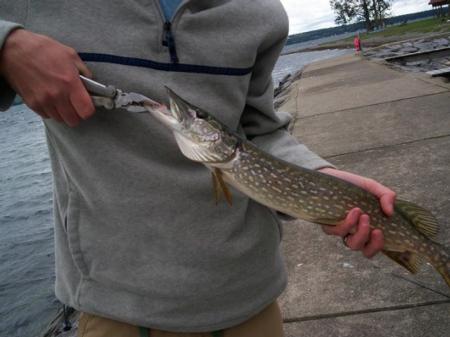Northern Pike
-
Scientific Name
Esox lucius - Visit ITIS or full scientific classification.
-
Description
 Northern Pike. Arthur Masloski. © 2007 Regents, University of California
Northern Pike. Arthur Masloski. © 2007 Regents, University of California- Freshwater fish with a cylindrical body shape and large, flattened snouts.
- Their snouts are half the length of their heads, and full of sharp teeth.
- Dark olive, or gray color on their backs and sides, with a white to yellow belly.
- The adults have rows of pale, oval spots that run along the length of their bodies, while the juveniles have rows of wavy lines.
- Northern Pike feed primarily on other fish, but will also feed on frogs, snakes, mammals, and birds.
- Possible for individuals to reach about 3 and a half feet long, and about 30 pounds.
-
Habitat
- Mostly found in shallow areas of cool lakes, slow running streams, and the backwaters of rivers with plenty of vegetation.
- Young fish hide within vegetation, and larger adults are found near the edge ready to ambush their prey.
- Northern Pikes can tolerate extreme environmental conditions including: low oxygen levels, brackish water, and a wide range of temperatures.
-
Invasion Pathways and Distribution
- Northern Pikes are used as game fish, and have been introduced both legally and illegally to many areas across the U.S. for the purposes of establishing sport fisheries.
- Native to the Great Lakes and surrounding states. See USGS for current U.S. distribution.
-
Life History
- Mating season is February through April, when the water temperature is around 40-65 degrees F.
- Spawning usually occurs in shallow areas with dense vegetation.
-
Impacts
- These aggressive top predators eat a variety of different animals but feed primarily on other fishes.
- They can alter food webs, decrease the number of native fishes, and lower overall species diversity.
-
References and Useful Links
For references by category and links to other useful AIS sites see our LEARN MORE page.


